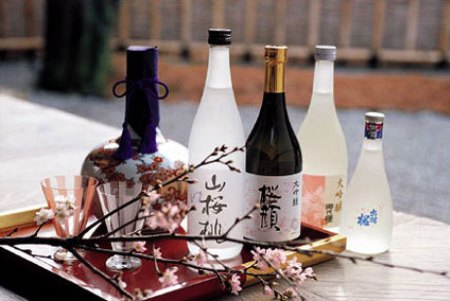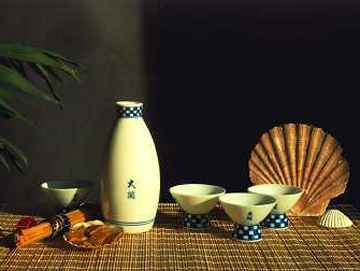Other Brands
Sake is an alcoholic beverage of Japanese origin that is made from fermented rice. It may also be spelled saké or saki.

In the Japanese language, the word sake refers to any alcoholic beverage, while the beverage called sake in English is termed nihonshu(日本酒, "Japanese liquor").
Serving sake
Sake can be served in a wide variety of cups; here is a sakazuki (a flat, saucer-like cup), an ochoko (a small, cylindrical cup), and a masu (a wooden, box-like cup).
In Japan sake is served chilled, at room temperature, or heated, depending on the preference of the drinker, the quality of the sake, and the season. Typically, hot sake is a winter drink, and high-grade sake is not drunk hot, because the flavors and aromas will be lost. This masking of flavor is the reason that low-quality and old sake is often served hot.

3 types of sake cup
Sake is usually drunk from small cups called choko, and poured into the choko from ceramic flasks called tokkuri. Saucer-like cups called sakazukiare also used, most commonly at weddings and other ceremonial occasions. Recently, footed glasses made specifically for premium sake have also come into use.
Another traditional cup is the masu, a box usually made of hinoki or sugi, which was originally used for measuring rice. In some Japanese restaurants, as a show of generosity, the server may put a glass inside the masu or put the masu on a saucer and pour until sake overflows and fills both containers.

Aside from being served straight, sake can be used as a mixer for cocktails, such as tamagozake, saketinis, nogasake, or the sake bomb.
Varieties
There are two basic types of sake: Futsū-shu ( Ordinary sake) and Tokutei meishō-shu ( special-designation sake). Futsū-shu is the equivalent of table wine and accounts for the majority of sake produced. Tokutei meishō-shu refers to premium sakes distinguished by the degree to which the rice has been polished and the added percentage of brewer's alcohol or the absence of such additives. There are eight varieties of special-designation sake: Junmai Daiginjō-shu (Pure rice, Very Special brew), Daiginjō-shu (Very Special brew), Junmai Ginjō-shu (Pure rice, Special brew), Ginjō-shu (Special brew), Tokubetsu Junmai-shu (Special Pure rice), Tokubetsu Honjōzō-shu (Special Genuine brew), Junmai-shu (Pure rice), Honjōzō-shu (Genuine brew).
- Drambuie wine (12/07/2013)
- Apfelwein (08/07/2013)
- Tequila Rose (05/07/2013)
- Nannerl (03/07/2013)
- Bacardi Gold (02/07/2013)
- Blue Curacao (26/06/2013)
- Sam seng wine company (29/03/2013)





